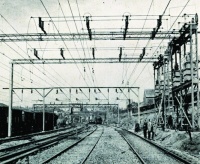
Electrification of the rail network in the UK has taken place gradually over time and today forms a key part of the government’s drive to lower transport emissions. In 1960 The Engineer took a look at the first British railway electrification on the Manchester-Crewe line, which was seen as an important step in creating a new electric rail infrastructure in the UK.
’In the course of the press inspection of the line, the ability of the type A locomotive to reach their nominal maximum of 100 mph was demonstrated,’ reported The Engineer.
’[The] locomotive, one of those supplied by The English Electric Company, covered some five miles with a five-coach train at a minimum of 97 mph and reached 102.3 mph while still accelerating between Goostrey and Chelford.’
The previous decade had seen a preference for 25kV 50 Hz in place of 1,500 V DC and later became the standard for all mainline electrification outside the south of England.
Register now to continue reading
Thanks for visiting The Engineer. You’ve now reached your monthly limit of premium content. Register for free to unlock unlimited access to all of our premium content, as well as the latest technology news, industry opinion and special reports.
Benefits of registering
-
In-depth insights and coverage of key emerging trends
-
Unrestricted access to special reports throughout the year
-
Daily technology news delivered straight to your inbox










Water Sector Talent Exodus Could Cripple The Sector
Well let´s do a little experiment. My last (10.4.25) half-yearly water/waste water bill from Severn Trent was £98.29. How much does not-for-profit Dŵr...